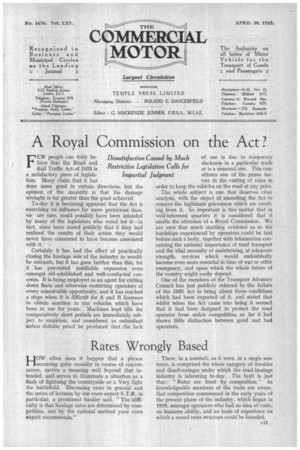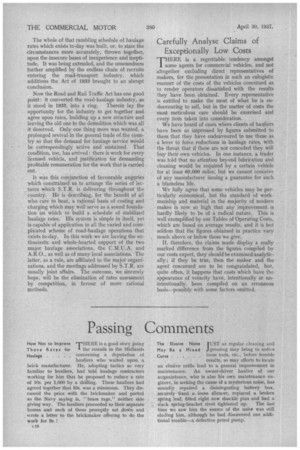Rates Wrongly Based
Page 71

Page 72

If you've noticed an error in this article please click here to report it so we can fix it.
UOW often does it happen that a phrase I ',occurring quite casually in course of conversation, carries a meaning well beyond that intended, and serves to illuminate a situation as a flash of lightning the countryside or a Very light the battlefield. Discussing rates in general and the series of lectures by our costs expert S.T.R. in particular, a prominent haulier said, "The difficulty is that haulage rates are determined by competition, not by the rational method your costs expert recommends." There, in a nutshell, as it were, in a single sentence, is comprised the whole category of troubles and disadvantages under which the road-haulage industry is labouring to-day. The fault is just that: "Rates are fixed by competition." As knowledgeable members of the trade are aware, that competition commenced in the early years of the present phase of the industry, which began in. 1919, amongst operators who had no idea of costs, no business ability, and no basis of experience on which a sound rates structure could be founded. The whole of that rambling schedule of haulage rates which exists to-day was built, or, to state the circumstances more accurately, thrown together, upon the insecure bases of inexperience and ineptitude. It was being extended, and the unsoundness further amplified by the endless chain of recruits entering the road-transport industry, which additions the Act of 1933 brought to an abrupt conclusion.
Now the Road. and Rail Traffic Act has one good point : it converted the road-haulage industry, as it stood in 1933, into a ring. Therein lay the opportunity for the industry to get together and agree upon rates, building up a new structure and leaving the old one to the demolition which was all it deserved. Only one thing more was wanted, a prolonged revival in the general trade of the country so that the demand for haulage service would be correspondingly active and sustained. That condition, too, has arrived : there is work for every licensed vehicle, and justification for demanding profitable remuneration for the work that is carried out.
It was this conjunction of favourable auguries which constrained us to arrange the series of lectures which S.T.R. is delivering throughout the country. He is describing, for the benefit of all who care to hear, a rational basis of costing and charging which may well serve as a sound foundation on which to build a schedule of stabilized haulage rates. His system is simple in itself, yet is capable of application to all the varied and complicated scheme of road-haulage operations that exists to-day. In this work we are having the enthusiastic and whole-hearted support of the two major haulage associations, the C.M.U.A. and A.R.O., as well as of many local associations. The latter, as a ride, are affiliated to the major organizations, and the meetings addressed by S.T.R. are usually joint affairs. The outcome, we sincerely hope, will be the elimination of rates assessment by competition, in favour of more rational methods.
Carefully Analyse Claims of Exceptionally Low Costs
THERE is a regrettable tendency amongst some agents for commercial vehicles, and not altogether excluding direct representatives of makers, for the presentation in such an eulogistic manner of the costs of the vehicles concerned as to render operators dissatisfied with the results they have been obtained. Every representative is entitled to make the most of what he is endeavouring to sell, but in the matter of costs the most meticulous care should be exercised and every item taken into consideration.
We have heard of cases where clients of hauliers have been so impressed by figures submitted to thein that they have endeavoured to use these as a lever to force reductions in haulage rates, with the threat that if these are not conceded they will buy their own vehicles. In one instance, a trader was told that no attention beyond lubrication and cleaning would be required by a certain vehicle for at least 60,000 miles; but we cannot conceive of any manufacturer issuing a guarantee for such a blameless life.
We fully agree that some vehicles may be particularly economical, but the standard of workmanship and material in the majority of modern makes is now so high that any improvement is hardly likely to be of a radical nature. This is well exemplified by our Tables of Operating Costs, which are based on average results, and it is but seldom that the figures obtained in practice vary much above or below those we give.
If, therefore, the claims made display a really marked difference from the figures compiled by our costs expert, they should be examined analytically ; if they be true, then the maker and the agent concerned are to be congratulated, but, quite often, it happens that costs which have the appearance of veracity have, intentionally or unintentionally, been compiled on an erroneous basis—possibly with some factors omitted.








































































































































































